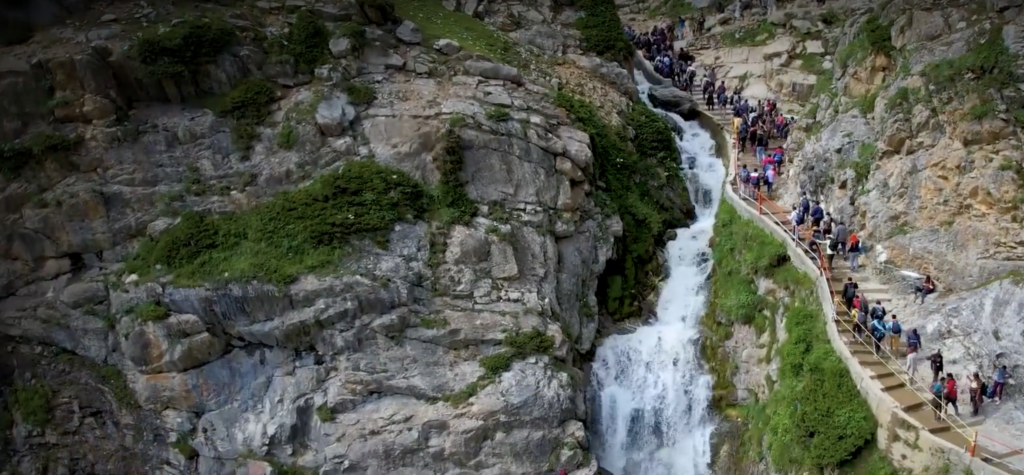Srinagar, June 25, 2025 – The annual Shri Amarnath Yatra, one of Hinduism’s most revered pilgrimages, is set to commence on July 3, 2025, and conclude on August 9, 2025, as announced by the Shri Amarnath Ji Shrine Board (SASB). This 38-day spiritual trek to the holy Amarnath Cave, nestled at 3,880 meters in the Himalayas of Jammu and Kashmir, draws lakhs of devotees to witness the naturally formed ice Shivling, a symbol of Lord Shiva. This year’s pilgrimage, however, is marked by heightened security measures and logistical changes following a terror attack in Pahalgam on April 22, 2025.
Key Details of the Amarnath Yatra 2025
- Dates: July 3 to August 9, 2025.
- Routes: Pilgrims can choose between the traditional 48-km Pahalgam route in Anantnag district or the shorter, steeper 14-km Baltal route in Ganderbal district.
- Registration: Open to devotees aged 13–70, registration is mandatory and available online or offline. Pilgrims must adhere to health guidelines, carry a Yatra Permit, Aadhaar Card, and RFID badge for verification at checkpoints.
- No Helicopter Services: Both Pahalgam and Baltal routes have been declared “No Flying Zones” from July 1 to August 10, 2025, prohibiting helicopter services due to security concerns post the Pahalgam attack. Pilgrims must trek on foot or use ponies and palkis (palanquins).
- Accommodation: Insulated huts and weather-resistant tents are available at camps along both routes, bookable on-site, to protect pilgrims from the harsh Himalayan weather.Security Measures BolsteredThe April 22 terror attack in Pahalgam, which claimed 26 lives, has prompted unprecedented security arrangements. Over 45,000 personnel from the CRPF, ITBP, Jammu and Kashmir Police, and Indian Army are deployed across the routes, with the Pahalgam route divided into 17 zones and 51 sectors for operational efficiency.
- AI Technology: AI-enabled facial recognition systems and drone-based reconnaissance are in use at key checkpoints to enhance pilgrim safety.
- Cordon and Search Operations: More than 20 daily operations are conducted along the routes and surrounding forests to sanitize the terrain.
- Base Camp Security: The Bhagwati Nagar Yatri Niwas in Jammu, the primary base camp, is under tight surveillance, with CRPF conducting anti-sabotage operations and additional checkpoints planned in Jammu, Samba, and Kathua districts.
- No-Fly Zone: The routes, including Lakhanpur-Jammu-Qazigund-Pahalgam and Lakhanpur-Jammu-Qazigund-Srinagar-Sonamarg, are designated as no-fly zones to mitigate aerial threats, a decision backed by the Union Home Ministry.Logistical and Community SupportThe Jammu and Kashmir administration, in coordination with the SASB, has been preparing since February 2025 to ensure a seamless pilgrimage.
- Infrastructure: The Jammu Municipal Corporation has inspected lodging centers like Shri Ram Mandir, Geeta Bhawan, and Yatri Niwas at Bhagwati Nagar to ensure pilgrim comfort. Transit camps, such as Pantha Chowk in Srinagar, are equipped with boarding, sanitation, and medical facilities.
- Local Hospitality: The Kashmir Traders and Manufacturers Federation (KTMF) has pledged full support, emphasizing the region’s tradition of welcoming pilgrims with warmth and interfaith harmony.
- Economic Boost: The Yatra is expected to revive tourism and boost the local economy, with 16 tourist destinations reopened since June 17, 2025, after the Pahalgam attack.Pilgrim Safety and GuidelinesThe high-altitude trek demands physical and mental preparation. Pilgrims are advised to:
- Avoid smoking, alcohol, and caffeine to prevent dehydration.
- Walk at a steady pace and use authorized shelters for rest.
- Stay mindful of volatile weather and avoid unsanctioned detours.
- Practice pranayam (breathing exercises) to acclimatize to the altitude.Lieutenant Governor Manoj Sinha, also SASB Chairman, recently trekked to the cave via the Baltal route, reviewing safety upgrades like widened tracks and ILCB tiles on high-risk segments. Union Tourism Minister Gajendra Singh Shekhawat has assured pilgrims of “topmost security,” urging tourists to explore Kashmir’s cultural heritage alongside the Yatra.Spiritual SignificanceThe Amarnath Yatra is more than a trek; it’s a journey of devotion, testing faith and resilience. The cave, accessible via the scenic Pahalgam and Sonmarg routes, holds deep spiritual significance, with locals serving as its custodians for centuries. As preparations peak, the Yatra promises a blend of spirituality, community support, and robust safety measures.Keywords: Shri Amarnath Yatra 2025, Amarnath Cave, Jammu and Kashmir, Pahalgam route, Baltal route, Shri Amarnath Ji Shrine Board, pilgrim security, no-fly zone, AI facial recognition, high-altitude trek, ice Shivling, Lord Shiva, Yatra registration, Bhagwati Nagar base camp, Kashmir hospitality, terror attack Pahalgam




